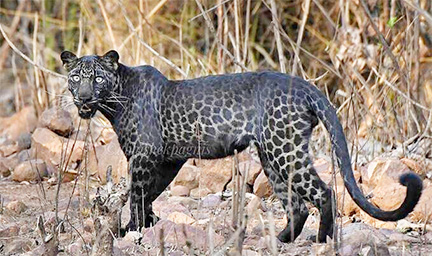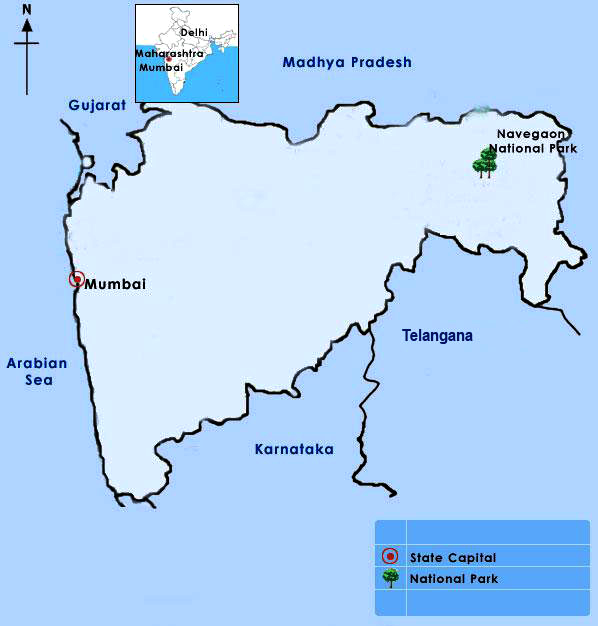Biodiversity & Environment
Black Panther Spotted in Navegaon-Nagzira Tiger Reserve
- 07 Jul 2021
- 4 min read
Why in News
Recently, a rare Melanistic Leopard (commonly known as Black Panther) has been recorded in Navegaon-Nagzira Tiger Reserve (NNTR) of Maharashtra.
Key Points
- Melanistic Leopard/Black Panther:
- About:

- Leopards (Panthera Pardus) are either light colored (pale yellow to deep gold or tawny) with black rosettes or with black fur.
- The melanistic leopards, which are either all-black or very dark in coloration, are known as black panthers. It is a color variant of spotted Indian leopards, reported from densely forested areas of south India.
- Black coat coloration is attributed to the expression of recessive alleles in leopards and dominant alleles in jaguars. In each species, a certain combination of alleles stimulates the production of large amounts of the dark pigment melanin (Melanism) in the animal’s fur and skin.
- The appearance of a black coat may be influenced by other factors, such as the angle of incident light and the animal’s life stage.
- It is as shy as a normal leopard and very difficult to detect.
- Habitat:
- They are mainly in Southwestern China, Burma, Nepal, Southern India, Indonesia, and the southern part of Malaysia.
- In India they can be spotted in the states of Karnataka, Tamil Nadu, Kerala, Maharashtra etc.
- Threats:
- Habitat loss.
- Collision with vehicles.
- Diseases.
- Human encroachment.
- Poaching.
- Protection Status:
- IUCN Red List: Vulnerable.
- CITES: Appendix I.
- Wildlife (Protection) Act, 1972: Schedule I.
- About:
- Navegaon-Nagzira Tiger Reserve:

- About:
- It is situated in Gondia and Bhandara districts of Maharashtra.
- Strategically, the Tiger Reserve is located in the heart of central Indian Tiger landscape which contributes almost one sixth of the total tiger population of the country.
- Formation:
- It was designated as the 46th Tiger Reserve of India in December 2013.
- It comprises the notified area of Navegaon National Park, Navegaon Wildlife Sanctuary, Nagzira Wildlife Sanctuary, New Nagzira Wildlife Sanctuary and Koka Wildlife Sanctuary.
- Connectivity:
- NNTR has connectivity with the major tiger reserves in Central India like,
- Kanha and Pench tiger reserve in Madhya Pradesh,
- Tadoba-Andhari Tiger reserve in Maharashtra,
- Indravati Tiger Reserve in Chhattisgarh,
- Indirectly with the Kawal and Nagarjuna Sagar in Telangana and Andhra Pradesh and, Achanakmar Tiger reserve in Chhattisgarh.
- It is also connected to important tiger bearing areas like Umred-Karhandla sanctuary and Brahampuri Division (Maharashtra).
- NNTR has connectivity with the major tiger reserves in Central India like,
- Flora:
- The major forest type is "Southern Tropical Dry Deciduous Forest".
- Few thorny plants are also found and Bamboo occurs in abundance.
- Fauna:
- Carnivores such as leopards and smaller carnivores like wild dogs, wolf jackals, jungle cats and also the good population of sloth bears are seen.
- Herbivore includes Cheetal, Sambar, Nilgai, Chousingha, Barking deer, Wild pig, Indian gaur and Mouse deer.
- More than 300 species of birds have been reported from the area.
- Other Protected Areas in Maharashtra:
- Sahyadri Tiger Reserve.
- Melghat Tiger reserve.
- Great Indian Bustard Sanctuary.
- Karnala Bird Sanctuary.
- Sanjay Gandhi National Park.
- Pench National Park.
- About:




